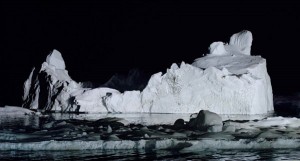« Reviews
“Crown Of The Lost” Inaugurates FIFI projects in New York
May 16 - July 16, 2009
By Ernesto Menéndez-Conde
Last May 16th, the FIFI projects gallery in New York was officially inaugurated. The space, located in the Lower East Side of Manhattan, has a well-defined identity. As the owners of the place told me, they will be devoted to promoting video art, contemporary photography, and occasionally experimental music, as part of video installations. They also attempt to promote art in which formalistic, visual, sensual, and poetic values prevail, far away from socially committed or critical art.
These goals have been quite explicit in the first collective show, which assembled six photographers. All of them demonstrate highly sophisticated knowledge of the medium, and develop personal poetics, which mostly call upon the pictorial qualities and plasticity of photography.
The young Mexican photographer, Giovanni Cervantes, works on pictures that combine subtly erotic and very spontaneous gestures, with psychological portraits of his young female models. Cervantes grasps moments of intimacy. For this show, he exhibits a couple of images in which the model is against the light. Light floods the female face and, at the same time, contributes to emphasizing her intense expression.
Another photographer, the Norwegian artist, Julie Pike, is also interested in the female body. Her picture, like the ones shown by Cervantes, also has strong pictorial qualities. She made an image of a young girl seen from behind. Her back traces a beautiful, elegant curve, which for me was sort of what Barthes called “punctum,” against the delicate, transparent, white cloth that covers the lower part of the female body.
The other four photographers work with views of nature and landscapes. Nature, with these four artists, becomes aestheticized, transformed both by contemporary society and the gaze of the artists. As the American Marxist thinker Fredric Jameson has claimed, in Postmodernism we cannot talk about nature anymore. There is nothing that can be seen as nature, in the pristine, virginal sense. Nature has gone for good, writes Jameson (1). Commodification has subsumed it. What we have today are culturalized landscapes, visually affected by man’s intervention, and inserted into processes of social exchange and productivity (2). The work of the Austrian photographer, Mathias Kessler, one of the main pieces of the show, could be very appropriate for illustrating Jameson’s argument. Kessler travels to Greenland and brings back pictures of icebergs that somehow look like artificial paradises, or better said, theatrical stages.
Christoph Morlinghaus takes very close views of plants, as if he were really about to touch the vegetal and floral elements he includes in his pictures. Not only does his viewpoint seem unnatural, but also his illumination of the image produces an unreal, denaturalized, almost morbid spectacle.
Debra Holt shows an enigmatic diptych - two images of almost the same shot, as if they were mirroring each other and, at the same time, creating a cloudy sphere. The artwork has a dramatic, perhaps even apocalyptic dimension that could be related to the uncanny beauty of an atomic explosion.
The Mexican photographer, Eliud Carrizales, takes pictures of plants in architectonical, closed places. This coexistence underlines the rarified insertion of nature in urban spaces. Hugo López shows two images. They both have a remarkable simplicity: a view of the natural light of the sky at dusk, and another of a fluorescent light. In both cases there is a powerfully expressive use of black, in sharp contrast with the light. To a certain extent, black in López’s pictures has autonomy as a surface, and it becomes almost an abstraction. López has a remarkable skill for creating an emotional communication through black and tonal contrasts.
FIFI projects gallery has opened its doors in Manhattan with a group of excellent photographers, and an array of well-defined projects.
Notes
(1) Jameson, Fredric. Postmodernism, or the Cultural Logic of Late Capitalism. Duke University Press, Durham, NC, 1991, p. xi
(2) Op. cit, p. X
Filed Under: Reviews



































